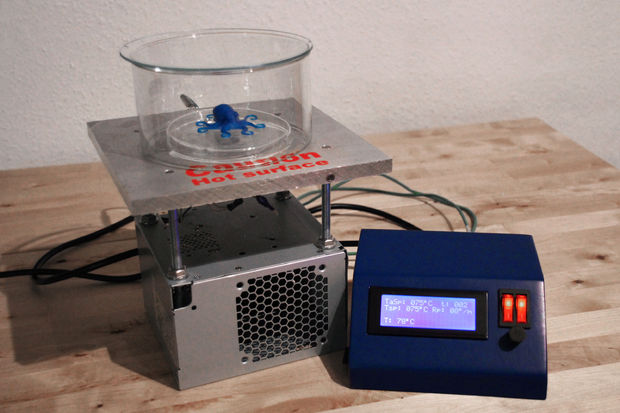When you need precise heating — like for the acetone polishing shown above — the control hardware is everything. Buying a commercial, programmable, controller unit can cost a pretty penny. Instead of purchasing one, try creating one from scratch like [BrittLiv] did.
[BrittLiv] is a Chemical and Biological Engineer who wanted something that performs well enough to be relied upon as a lab tool. Her design utilizes a plain, old hot plate and with some temperature feedback to run custom temperature ramps from programs stored on an SD card.
The system she developed was dealing directly with temperatures up to 338°F. The heating element is driven from mains, using an SSR for control but there is also a mechanical switch in there if you need to manually kill the element for some reason. An ATmega328 monitors the heating process via an MAX6675 thermocouple interface board. This control circuitry is powered from a transformer and bridge rectifier inside the case (but populated on a different circuit board).
She didn’t stop after getting the circuit working. The project includes a nice case and user interface that will have visitors to your lab oohing and aahing.















Ooh
Aah
Seriously though, nice build. Any risk of acetone + 338°F?
I’ve heat acetone with DIY resistance heater, few times I forgot to add more acetone, so there was acetone vapor and glowing red wire – after you go past 13% of acetone vapor in your container it’s “explosion safe”. (Explosion of acetone + air mix can occur between ~ 2% – 13% ).
As so I don’t like this method as it’s dangerous – there is no way to remove normal air, and leave acetone. Also acetone is dangerous for your health so you do not want to do stuff like that in closed areas. I would gladly see method which is safe, but hot is definitely not the way.
At least acetone can be ignited from -19*C to above (it won’t self ignite of heat plate it would need more than 500*C). I can imagine situations when she opens the lid few times in closed room, than there would be more than 2% of acetone in the air (it’s not that much) and than she hits something, drops or whatever and than explosion occurs…
Btw. why would you need precise temp for polishing, when you don’t measure other, more important stuff than temperature (f.e. how much acetone you’ve in air). Nice heater, but very stupid use of it – as so stupid hack.
In industry you have to do risk assessments before any new process or equipment is used, perhaps its time we got the maker community to think about this best practise, before someone burns their house down.
Plane (pun) old hot plate. Truly a plate with a huge space below it, weird. They are usually on the top of a base of metal and or Bakelite. Most are Calrod elements.
Or is this remounted?
I have an old lab model where the top is just the same but it’s on a base as big as a PC power supply. A friend is using it to cook.
I mounted a water heater thermostat to the underside of a Bunn coffee warmer part, not the boil element. It keeps traditional hide glue at 130-140F temp mixed in a tuna tin that is fixed in place but changeable when shot. A foot switch operates the lid with a notch in the can for the brush.
Why did you not use any PID temperature controller. They allow to set up and store several profiles
>Buying a commercial, programmable, controller unit can cost a pretty penny.
$13 with free shipping to be exact (REX C100)
…and sometime they even throw in the thermocouple.
They aren’t ‘programmable’ in the sense that you can have different heating profiles. The will autotune to match your setup though.
Another bonus is they have oddities in the firmware; one unit I have will allow you to select C/F display, but only show Celcius; the firmware supports a 2nd alarm but the parts aren’t populated and so on.
But when the whole unit is less than the price of a thermocouple chip…
Yep. its $70 If you need zones control, ALTEC PC410 gets you 10 profiles, 8 temp zones each.